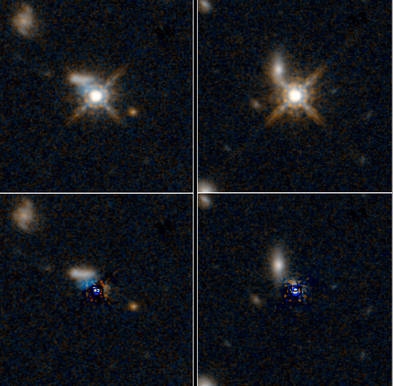Exploring Quasars and the Evolution of Galaxies

MIDDLEBURY, Vt. – Using infrared images from the Hubble Space Telescope, a Middlebury College astrophysicist is determining the form and structure of red quasars in galaxies nearly 10 billion light years away, and her research is contributing to science’s understanding about the evolution of galaxies in the universe.
Eilat Glikman, assistant professor of physics and Middlebury’s first Winkler fellow in astronomy, is the lead author of a paper published in June in The Astrophysical Journal. The study confirms the theory that the energy output from quasars – the most luminous objects in the universe – comes from the merging of two galaxies.
Using the Hubble’s sensitivity at near-infrared wavelengths of light, Glikman and her team of researchers were able to subtract the intense glow of 11 ultra-bright quasars to see into the host galaxies themselves.
The new images of dust-reddened quasars “capture the transitional phase in the merger-driven black hole scenario,” Glikman said. “The Hubble observations are telling us that the peak of quasar activity in the early universe is driven by galaxies colliding and then merging together.”
Discovered in the 1960s, quasars can emit the light of as many as one trillion stars from a region of space smaller than our solar system. It took more than two decades of research to conclude that a quasar’s gusher of energy comes from the infall of gas onto a supermassive black hole in the core of a distant galaxy. And now with the Hubble’s infrared images and researchers’ ability to analyze the data from galaxies billions of light years away, astronomers have a better understanding of the mechanism that feeds gas into the quasars, enabling them to shine so brightly.

We are looking at light from when the universe was very young,” Glikman said. “We are seeing these quasars in their teenage years, when they are growing quickly and all messed up.”
Science has been trying to understand why galaxies start feeding their central black holes, and the recent study by Glikman and five other researchers – including a Middlebury College undergraduate – indicates that galaxy collisions (or “mergers”) are the leading hypothesis.
Physics major Madeline Mailly, a 2014 graduate, did research for the project with Glikman and others as part of her senior work. As the third of six authors on the just-published paper “Major Mergers Host the Most Luminous Red Quasars at z ~ 2,” Mailly used the Hubble images to analyze the PSFs, or point spread functions, of 11 dust-reddened quasars.
“It was incredibly laborious work,” said Glikman, “but Maddie was deeply invested in this research with me. She spent most of her time building the PSFs by digging into the Hubble images, finding other stars in the image, identifying them, and adding them all up until she had a nearly perfect representation of the 11 quasars. Then the PSFs could be removed to unveil an image of the underlying host galaxy.”
Mailly said the research project was a highlight of her academic experience.

“Dust-reddened quasars are part of a process that occurred only a few billion years after the start of the Universe, so every time I entered the lab and looked at our Hubble Space Telescope images, I was taken back in time,” Mailly related in an email from Japan.
“I was fortunate to have a role in this growing field of research, and I am grateful for Professor Glikman’s encouragement, patience, and expertise that made the research project such an enjoyable and fulfilling experience.”
The authors of the study concluded that “major mergers [of galaxies] are the dominant drivers of black hole growth at the highest luminosities as far back in time as the epoch of peak quasar and star formation activity.”
By removing the quasar light and studying the morphology of each underlying host galaxy, the researchers found clear evidence of mergers in eight out of the 11 systems.
Their science also delved into the angular motion responsible for the beautiful spiral disks seen in galaxies because, as Glikman explained, “when two galaxies crash into each other, it affects these nice neat orbits and some objects get pushed into the black hole and others get pushed out.”
The project was supported by the Research Corporation for Science Advancement, the Space Telescope Science Institute, and the Michele and David Mittelman Family Foundation.
For more details, read NASA’s news story about Eilat Glikman’s research.
- With reporting by Robert Keren

